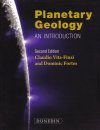Textbook
By: Claudio Vita-Finzi(Author), Dominic Fortes(Author)
206 pages, colour & b/w photos, colour illustrations, tables
![Planetary Geology Planetary Geology]()
Click to have a closer look
About this book
Contents
Customer reviews
Biography
Related titles
Recommended titles
About this book
Recent planetary missions by NASA, the European Space Agency, and other national agencies have reaffirmed that the geological processes which are familiar from our studies of the Earth operate on many solid planets and satellites. Common threads link the internal structure, thermal evolution, and surface character of both rocky and icy worlds. Volcanoes, impact craters, ice caps, dunes, rift valleys, rivers, and oceans are features of extra-terrestrial worlds as diverse as Mercury and Titan. New data reveals that many of the supposedly inert planetary bodies were recently subject to earthquakes, landslides, and climate change, and that some of them display active volcanism. Moreover, our understanding of the very origins of the Solar System depends heavily on the composition of meteorites from Mars reaching the Earth and of rock fragments found on the Moon.
Planetary Geology provides the student reader and enthusiastic amateur with comprehensive coverage of the solar system viewed through the eyes of Earth scientists. Combining extensive use of imagery, the results of laboratory experiments, and theoretical modeling, this comprehensively updated second edition presents fresh evidence that planetary geology now embraces conventional geology and vice versa.
Contents
1 Planetary origins
2 Orbits and cycles
3 Core, mantle and crust
4 Magnetic fields and signatures
5 Topography and gravity
6 Tectonics
7 Volcanism
8 Impacts
9 Atmospheres
10 Oceans and ice caps
11 Water, wind and stratigraphy
12 Planetary biology. References cited
Glossary
Index
Customer Reviews
Biography
Claudio Vita-Finzi taught planetary geology at University College London (UCL) for a dozen years before moving to the Natural History Museum as a scientific associate. He is working on solar history.
Dominic Fortes studied the physical properties of planetary ices under the auspices of a UCL Graduate School Scholarship and two STFC-funded Research Fellowships over a ten-year period in the UCL Department of Earth Sciences. Currently working in the Institute for Earth and Planetary Sciences at UCL and Birkbeck College, he continues this work on planetary ices and the application to understanding the evolution of these fascinating objects, and lectures on the geology of planetary bodies.



































